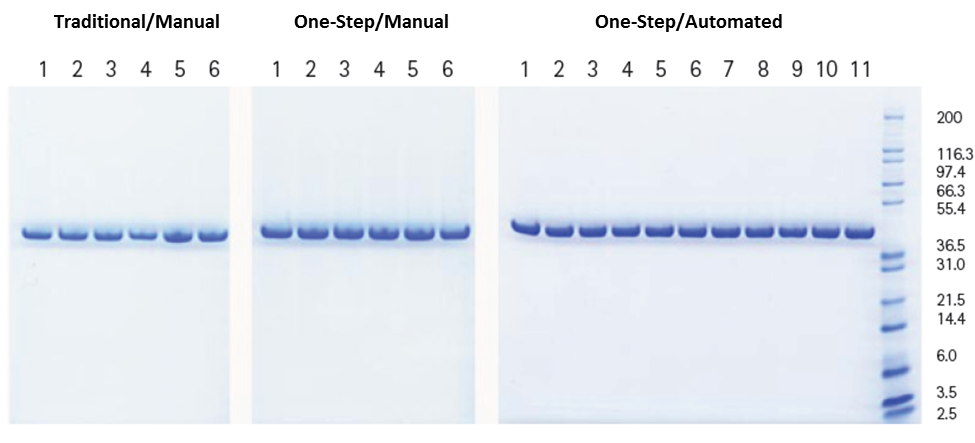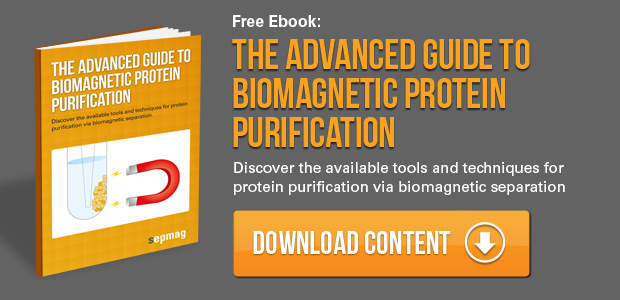A need for rapid, reproducible, small-scale purification
For many recombinant protein applications, such as expression clone screening and for optimizing expression conditions, there is a crucial need for a rapid, reproducible, small-scale purification process. Traditionally, protein purification from E. coli consists of four distinct phases: harvest, bacterial cell lysis, lysate clarification and protein purification. You will find the whole process explained step by step in our protein purification handbook.

Bacterial lysis typically requires several time-consuming, potentially harsh, hands-on steps, such as freeze/thaw cycles in combination with sonication or the use of other mechanical disruption techniques such as French Press. Because these harsh lysis techniques may negatively impact protein quality and contribute greatly to sample-to-sample variability, detergent-based lysis buffers and enzymes are routinely used to avoid mechanical extraction, preserving protein activity and integrity.
Regardless of the lysis method used, centrifugation is traditionally required to pellet cell debris and permit recovery of the clarified lysate. The final step, purification, is frequently performed using affinity media specific for expressed epitope tags. Agarose-based media have typically been used, either as slurry in microcentrifuge tubes or packed into gravity-driven or spin columns. While easier to manipulate, columns are greatly affected by lysate consistency and carryover of cell debris, which can lead to detrimental clogging of the column frits. Although spin columns are a convenient solution when processing multiple samples, proteins can easily denature when columns are spun to dryness.
The answer: combining lysis and purification using magnetic beads
A one-step protocol, involving magnetic affinity capture beads, has been developed that condenses the traditional recombinant protein purification workflow by combining enzymatic lysis and purification steps. This results in significantly less hands-on time and a greater than two-hour time savings over the traditional workflow. Compared to agarose beads, magnetic beads can reduce processing time and increase sample throughput, especially if adapted for automated particle processors.
Certain optimized magnetic beads for capturing histidine-tagged proteins have been successfully used to accelerate both manual and automated purification processes1,2. These beads are ideal for expression clone screening and small-scale purification, providing purified recombinant proteins at high purity. Magnetic beads are generally used in batch mode and are captured by a magnet for simple exchange of sample, wash or elution buffers. This magnetic bead capture allows for unwanted material to be easily washed away.
Protocol for rapid, one-step small-scale purification
The one-step lysis and purification protocol has been validated specifically for PureProteome™ Nickel Magnetic Beads and BugBuster® Master Mix, a lysis reagent that combines detergent-based lysis with a nuclease and recombinant lysozyme for gentle extraction of soluble protein from bacterial cells in as little as 30 minutes. The protocol has not yet been validated for other affinity beads or lysis reagents.
For recombinant protein purification, buffer and magnetic beads are added directly to the E. coli pellet. After complete re-suspension of the pellet, the mixture is incubated with gentle end-over-end rotation. During this incubation, cells are lysed, nucleic acid is digested and the liberated recombinant protein is immediately captured by the magnetic beads. After removal of the unbound fraction, beads are washed with buffer containing 10 mM imidazole to eliminate loosely bound contaminants, residual lysate and cell debris. The captured proteins are eluted from the beads with high specificity using elution buffer containing 300 mM imidazole. Compared to the results of a traditional purification process involving mechanical extraction (Figure 1, left panel), the one-step protocol delivers increased reproducibility with equal or greater yield (Figure 1, center and right panels).
Figure 1. SDS-PAGE analysis of His-tagged GAPDH protein purified using traditional and one-step recombinant protein purification protocols using PureProteome™ Nickel Magnetic Beads and BugBuster® Master Mix. The one-step protocol was performed manually as well as on an automated magnetic bead handler.
One-step lysis and purification is an easy, flexible technique, whether adapted to a manual or automated processing workflow, requires significantly less hands-on time and a greater than two-hour time savings over the traditional workflow, while reducing overall sample–to-sample variability. An automated approach incorporating the one-step lysis and purification protocol further reduces hands-on time and significantly increase sample throughput.
-
EMD Millipore Corporation. 2013. Automated IgG Purification Using PureProteome™ Magnetic Beads. Literature No. AN1255EN00.
-
EMD Millipore Corporation. 2013. Automated purification of proteins from non-clarified E.coli lysate using BugBuster® Master Mix and PureProteome™ Nickel Magnetic Beads. Literature No. AN9377EN00.
You will find this post and many more interesting articles about using biomagnetic separation for protein purification in our Advanced Guide to Biomagnetic Protein Purification:
Related articles:
- Effect of Particle Size Distribution of Magnetic Particles in Protein Purification Processes
- Multi-functional Nanoparticles for Protein Purification
- Advanced Biomagnetic Separation Systems to Enable Protein Immunomagnetic Purification
Author: Anja Dedeo, Senior Scientist at EMD Millipore
Anja Dedeo is Senior Scientist at EMD Millipore. She has over 20 years experience in research and development of novel filtration devices, protein sample prep solutions and protein detection. She has contributed to the development of ZipTip® SCX tips, Montage® antibody purification kits and the PureProteome™ magnetic bead portfolio. She is currently leading a team supporting technology, product and application development.




